Filtering Assets
Anastasia Troichuk (Unlicensed)
Уou have the ability to use filters on the assets list to quickly find the assets you are interested in the most.
Filtering Criteria
On the redesigned assets list, assets can be filtered by the following criteria:
Tag ID, Asset Tag, Model #, Serial #, Tracking #. Pick the desired criteria from the drop-down list, and enter the value in the text field below.
To enter more than one Tag ID, Asset Tag, Model #, or Serial #, Tracking # add double forward slashes // between the values. For example, Asset 0932//Asset 3633//Asset 0444.
My Saved Filters. The drop-down list contains your saved filter sets.
Date Type. You can filter assets by the following date types:
Install Date
Deactivated Date
Warranty Expiration Date
Purchase Date
Lease Date
Once you’ve selected the desired date type, you should specify the time period.
Time Period. Depending on the date type you’ve picked, you can view assets for the following time periods:
Past month
Past 3 months
Past year
Range. Enter the start date and the end date.
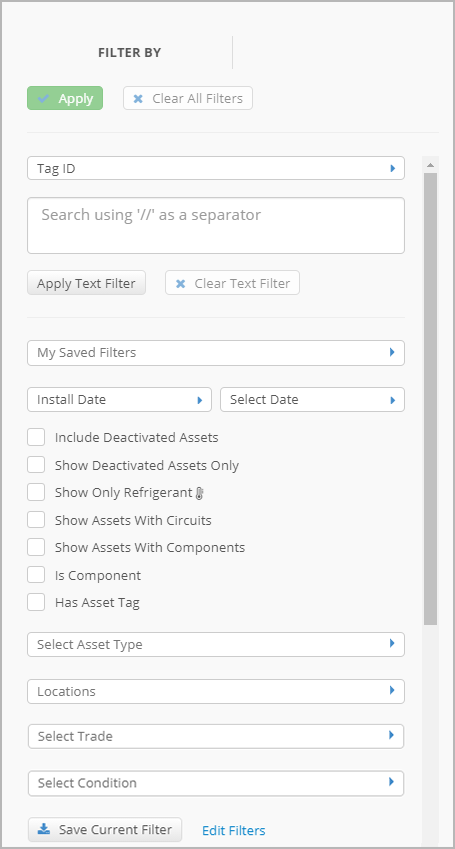
Include Deactivated Assets. Select the checkbox to display both active and deactivated assets. The tag IDs of deactivated assets will appear highlighted in red.

Show Deactivated Assets Only. Select the checkbox if you need to view only deactivated assets on the list.
Show Only Refrigerant. When the checkbox is selected, you get a list of assets belonging to the refrigerant type. These are assets with the Refrigeration and HVAC primary trades. You can quickly recognize refrigerant and HVAC assets by a thermometer icon next to the asset tag ID.

When your refrigerant or HVAC asset has an open leak record, you will see a warning icon.
Show Assets With Circuits. Allows you to view assets that have circuits. If you have, for example, refrigerators, electric pallet jacks, air conditioners, or scissor lifts, they will all appear among your search results once you select the checkbox. Parent assets that already have circuits or components added to the Asset Manager database have a blocks icon next to the asset tag ID.

Show Assets With Components. Shows assets that consist of various smaller parts. In other words, the filter retrieves parent assets that have children assets.
Is Component. Displays assets serving as parts that make up the equipment.
Has Asset Tag. Lists assets that have asset tags loaded to the system. The asset tag appears under the tag ID.

Asset Status: You can find assets that are currently in any of the following statuses. Read more about Asset Repair Statuses.
- In Use. The asset is up and running. This is the default status of all assets.
- Out For Repair. The provider cannot fix the faulty asset on site and takes it out for repair.
- Repaired: The asset has been repaired and is waiting to be returned into service.
- Replacement Recommended: The provider recommends that you replace the malfunctioning asset with another one.
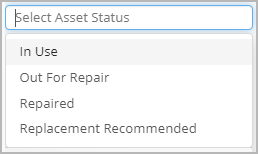
Asset Type. You can select an asset type from the drop-down list to view assets of a particular type only. Multiple asset types can be picked as well.
Locations. Allows you to find assets by location ID or address details. You can filter assets by:
City
Country
District
Location ID
Location Name
Region
State/Province
- Trade. You can quickly find the desired assets by the trade assigned to their asset type.
Condition. Permits you to get a list of assets based on the asset state: Broken, Poor, Average, Good, or Excellent. Multiple states can be picked as well.
- Warranty Status. You can get a list of assets that are still under warranty, have no warranty, or have an expired warranty.
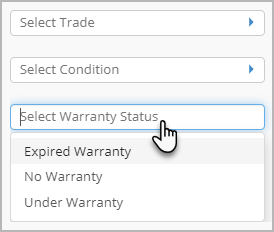
Applying Filters
Using filters is the best way to weed out assets you don’t need to view right now, leaving only those you want to view or take action on.
Navigate to the filters panel on the left-hand side of the assets list.
Pick the desired filtering criteria, and click Apply atop the filters panel.
The page updates showing you the assets that match the specified criteria.
Clearing Filters
When you no longer need the filters you applied earlier, you can easily remove them.
a. All Filters. To remove all the applied filters, click Clear All Filters atop the filters panel.
b. Some Filters. To clear some of the applied filters, remove the selected checkbox, or click the cross icon next to the unnecessary option. Then, click Apply.
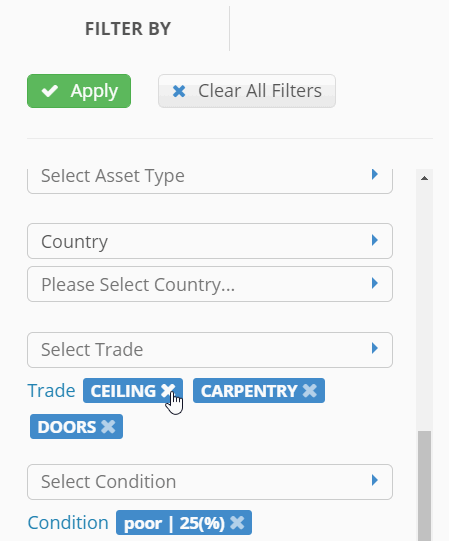
Saving a Filter Set
Filters can be saved and used at a later time. It saves you time and effort in case you need to filter assets by the same parameters more than once.
- Select the desired filtering criteria in the filters panel.
- Click Save Current Filter at the bottom of the panel.
- Enter a unique filter name, and click ✔ Save Filter.
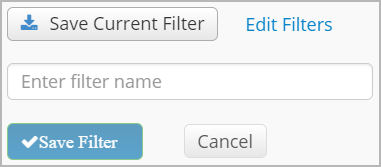
-
Page:
-
Page:
-
Page:
-
Page:
-
Page:
-
Page:
-
Page:
-
Page:
